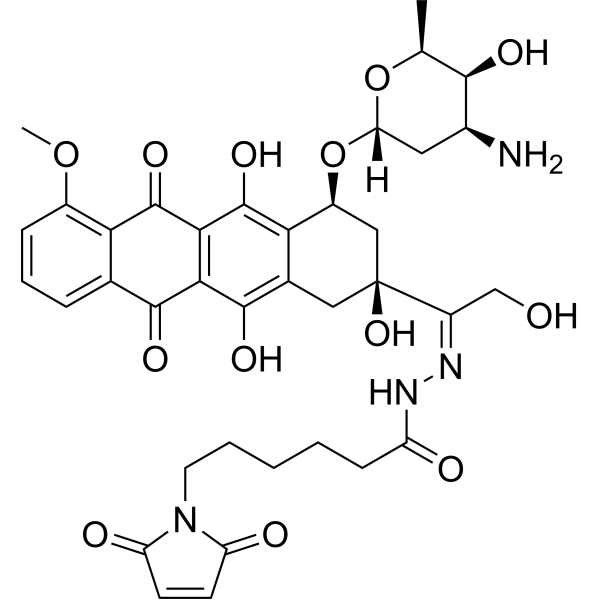
| 规格 | 价格 | |
|---|---|---|
| 500mg | ||
| 1g | ||
| Other Sizes |
| 靶点 |
Topoisomerase II Daunorubicins/Doxorubicins
|
|---|---|
| 体外研究 (In Vitro) |
羟阿霉素是一种抗肿瘤药物,是阿霉素的白蛋白结合前药
羟阿霉素是蒽环类抗生素阿霉素(DOXO-EMCH)的6-马来酰亚胺基腙衍生物前药,具有抗肿瘤活性。静脉注射后,羟柔比星通过其马来酰亚胺部分选择性结合白蛋白的半胱氨酸-34位。阿霉素在肿瘤的酸性环境中切割酸敏感腙接头后,从白蛋白载体中释放出来,一旦定位在细胞内,就会嵌入DNA,抑制DNA合成,并诱导细胞凋亡。由于高代谢周转、快速血管生成、高血管系统和淋巴引流受损,白蛋白倾向于在实体瘤中积聚。由于肿瘤内的被动积聚,该药物可以提高阿霉素的治疗效果,同时最大限度地减少全身毒性。 |
| 体内研究 (In Vivo) |
DOXO-EMCH是阿霉素的6-马来酰亚胺基丙酰腙衍生物,是一种白蛋白结合前药,因其优越的抗肿瘤和毒理学特性而进入临床试验。在目前的工作中,研究人员检查了DOXO-EMCH的慢性心脏毒性,并与阿霉素进行了直接比较。大鼠(11周龄)接受静脉注射阿霉素(每周0.8 mg/kg,持续7周)、等摩尔剂量的DOXO-EMCH(1.1 mg/kg)或3.3 mg/kg的DOXO-E MCH治疗。对照组接受生理盐水。动物在48周时被安乐死。暴露于阿霉素的大鼠出现严重的临床和组织病理学心肌病,细胞色素c氧化酶(COX,26%的对照组)的心肌活性降低,mtDNA编码的COX II亚基表达减少,mtDNA拷贝数减少(46%的对照组成员),丙二醛和超氧化物水平升高(787%的对照组人员)。所有参数均与心肌损伤高度相关。DOXO-EMCH组在临床症状、死亡率和线粒体酶方面与对照组没有差异,尽管高剂量组的心肌组织病理学异常略有增加,线粒体DNA拷贝数降低(对照组的74%),超氧化物水平升高(对照组中的347%)。阿霉素暴露的心脏,在较小程度上,DOXO-EMCH组的心肌都含有mtDNA缺失。总之,在心肌病的临床和组织病理学证据、心肌COX活性、COX II表达、mtDNA含量、mtDNA突变负荷和大鼠超氧化物产生方面,DOXO-EMCH剂量均优于阿霉素[2]。
|
| 动物实验 |
Male Wistar rats were housed in a normal night–day rhythm under standard conditions of temperature, humidity and fed a normal rat chow. At 10 weeks of age, the rats received an intravenous port under anesthesia with Forene™. Based on the mortality in earlier investigations, the rats were divided into 4 experimental groups of different size: 9 animals served as controls (Group A) and received intravenous saline (300–700 μl). Group B (n = 15) received equivalent volumes of doxorubicin at a dose of 0.8 mg/kg, freshly dissolved in water from lyophilized powder. Group C, the DOXO-EMCH low-dose group (n = 10), received intravenous DOXO-EMCH, synthesized according to a published procedure and freshly reconstituted in sterile 10 mM sodium phosphate, 5 % D-(+)-glucose (pH 6.4) and at a dose equivalent to 0.8 mg/kg of free doxorubicin (1.1 mg/kg). Group D (n = 10) was injected with a higher dose of DOXO-EMCH (3.3 mg/kg), a dose that with respect to subacute mortality was equitoxic to 0.8 mg/kg of doxorubicin in a 4-cycle repeat dose study in rats. All animals received 7-weekly injections through the port, beginning at 11 weeks of age and were killed by cervical dislocation at 48 weeks of age, immediately before postmortem examination and organ collection. Heart weights were recorded. Left ventricle and apex were snap frozen and cryopreserved in liquid nitrogen until subsequent analysis. Aliquots were fixed in glutaraldehyde (3%) for subsequent electron microscopy.[3]
|
| 参考文献 | |
| 其他信息 |
Aldoxorubicin, an antineoplastic agents, is an albumin-binding prodrug of doxorubicin.
Aldoxorubicin is a 6-maleimidocaproyl hydrazone derivative prodrug of the anthracycline antibiotic doxorubicin (DOXO-EMCH) with antineoplastic activity. Following intravenous administration, aldoxorubicin binds selectively to the cysteine-34 position of albumin via its maleimide moiety. Doxorubicin is released from the albumin carrier after cleavage of the acid-sensitive hydrazone linker within the acidic environment of tumors and, once located intracellularly, intercalates DNA, inhibits DNA synthesis, and induces apoptosis. Albumin tends to accumulate in solid tumors as a result of high metabolic turnover, rapid angiogenesis, hypervasculature, and impaired lymphatic drainage. Because of passive accumulation within tumors, this agent may improve the therapeutic effects of doxorubicin while minimizing systemic toxicity. Drug Indication Investigated for use/treatment in solid tumors. Mechanism of Action INNO-206 is the (6-Maleimidocaproyl) hydrazone of doxorubicin. INNO-206 is a prodrug of doxorubicin that binds endogenous albumin after administration. The bound doxorubicin is released in the acidic environment of the tumor cell through cleavage of an acid sensitive linker. In preclinical models, INNO-206 was superior to doxorubicin with regard to antitumor efficacy and toxicity. |
| 分子式 |
C37H42N4O13
|
|---|---|
| 精确质量 |
750.275
|
| CAS号 |
151038-96-9
|
| 相关CAS号 |
Aldoxorubicin;1361644-26-9;MC-DOXHZN hydrochloride;480998-12-7
|
| PubChem CID |
9810709
|
| 外观&性状 |
Typically exists as solid at room temperature
|
| LogP |
1.418
|
| tPSA |
267.84
|
| 氢键供体(HBD)数目 |
7
|
| 氢键受体(HBA)数目 |
15
|
| 可旋转键数目(RBC) |
12
|
| 重原子数目 |
54
|
| 分子复杂度/Complexity |
1510
|
| 定义原子立体中心数目 |
6
|
| SMILES |
[H][C@@]1(O[C@H]2C[C@@](/C(CO)=N\NC(CCCCCN3C(C=CC3=O)=O)=O)(O)CC(C2=C4O)=C(O)C5=C4C(C6=C(OC)C=CC=C6C5=O)=O)O[C@@H](C)[C@@H](O)[C@@H](N)C1
|
| InChi Key |
OBMJQRLIQQTJLR-USGQOSEYSA-N
|
| InChi Code |
InChI=1S/C37H42N4O13/c1-17-32(46)20(38)13-27(53-17)54-22-15-37(51,23(16-42)39-40-24(43)9-4-3-5-12-41-25(44)10-11-26(41)45)14-19-29(22)36(50)31-30(34(19)48)33(47)18-7-6-8-21(52-2)28(18)35(31)49/h6-8,10-11,17,20,22,27,32,42,46,48,50-51H,3-5,9,12-16,38H2,1-2H3,(H,40,43)/b39-23+/t17-,20-,22-,27-,32+,37-/m0/s1
|
| 化学名 |
N-[(E)-[1-[(2S,4S)-4-[(2R,4S,5S,6S)-4-amino-5-hydroxy-6-methyloxan-2-yl]oxy-2,5,12-trihydroxy-7-methoxy-6,11-dioxo-3,4-dihydro-1H-tetracen-2-yl]-2-hydroxyethylidene]amino]-6-(2,5-dioxopyrrol-1-yl)hexanamide
|
| 别名 |
ALDOXORUBICIN; 1361644-26-9; INNO-206; DOXO-EMCH; Doxorubicin-EMCH; 151038-96-9; MC-Doxhzn; N-[(E)-[1-[(2S,4S)-4-[(2R,4S,5S,6S)-4-amino-5-hydroxy-6-methyloxan-2-yl]oxy-2,5,12-trihydroxy-7-methoxy-6,11-dioxo-3,4-dihydro-1H-tetracen-2-yl]-2-hydroxyethylidene]amino]-6-(2,5-dioxopyrrol-1-yl)hexanamide;
|
| HS Tariff Code |
2934.99.9001
|
| 存储方式 |
Powder -20°C 3 years 4°C 2 years In solvent -80°C 6 months -20°C 1 month |
| 运输条件 |
Room temperature (This product is stable at ambient temperature for a few days during ordinary shipping and time spent in Customs)
|
| 溶解度 (体外实验) |
May dissolve in DMSO (in most cases), if not, try other solvents such as H2O, Ethanol, or DMF with a minute amount of products to avoid loss of samples
|
|---|---|
| 溶解度 (体内实验) |
注意: 如下所列的是一些常用的体内动物实验溶解配方,主要用于溶解难溶或不溶于水的产品(水溶度<1 mg/mL)。 建议您先取少量样品进行尝试,如该配方可行,再根据实验需求增加样品量。
注射用配方
注射用配方1: DMSO : Tween 80: Saline = 10 : 5 : 85 (如: 100 μL DMSO → 50 μL Tween 80 → 850 μL Saline)(IP/IV/IM/SC等) *生理盐水/Saline的制备:将0.9g氯化钠/NaCl溶解在100 mL ddH ₂ O中,得到澄清溶液。 注射用配方 2: DMSO : PEG300 :Tween 80 : Saline = 10 : 40 : 5 : 45 (如: 100 μL DMSO → 400 μL PEG300 → 50 μL Tween 80 → 450 μL Saline) 注射用配方 3: DMSO : Corn oil = 10 : 90 (如: 100 μL DMSO → 900 μL Corn oil) 示例: 以注射用配方 3 (DMSO : Corn oil = 10 : 90) 为例说明, 如果要配制 1 mL 2.5 mg/mL的工作液, 您可以取 100 μL 25 mg/mL 澄清的 DMSO 储备液,加到 900 μL Corn oil/玉米油中, 混合均匀。 View More
注射用配方 4: DMSO : 20% SBE-β-CD in Saline = 10 : 90 [如:100 μL DMSO → 900 μL (20% SBE-β-CD in Saline)] 口服配方
口服配方 1: 悬浮于0.5% CMC Na (羧甲基纤维素钠) 口服配方 2: 悬浮于0.5% Carboxymethyl cellulose (羧甲基纤维素) 示例: 以口服配方 1 (悬浮于 0.5% CMC Na)为例说明, 如果要配制 100 mL 2.5 mg/mL 的工作液, 您可以先取0.5g CMC Na并将其溶解于100mL ddH2O中,得到0.5%CMC-Na澄清溶液;然后将250 mg待测化合物加到100 mL前述 0.5%CMC Na溶液中,得到悬浮液。 View More
口服配方 3: 溶解于 PEG400 (聚乙二醇400) 请根据您的实验动物和给药方式选择适当的溶解配方/方案: 1、请先配制澄清的储备液(如:用DMSO配置50 或 100 mg/mL母液(储备液)); 2、取适量母液,按从左到右的顺序依次添加助溶剂,澄清后再加入下一助溶剂。以 下列配方为例说明 (注意此配方只用于说明,并不一定代表此产品 的实际溶解配方): 10% DMSO → 40% PEG300 → 5% Tween-80 → 45% ddH2O (或 saline); 假设最终工作液的体积为 1 mL, 浓度为5 mg/mL: 取 100 μL 50 mg/mL 的澄清 DMSO 储备液加到 400 μL PEG300 中,混合均匀/澄清;向上述体系中加入50 μL Tween-80,混合均匀/澄清;然后继续加入450 μL ddH2O (或 saline)定容至 1 mL; 3、溶剂前显示的百分比是指该溶剂在最终溶液/工作液中的体积所占比例; 4、 如产品在配制过程中出现沉淀/析出,可通过加热(≤50℃)或超声的方式助溶; 5、为保证最佳实验结果,工作液请现配现用! 6、如不确定怎么将母液配置成体内动物实验的工作液,请查看说明书或联系我们; 7、 以上所有助溶剂都可在 Invivochem.cn网站购买。 |
计算结果:
工作液浓度: mg/mL;
DMSO母液配制方法: mg 药物溶于 μL DMSO溶液(母液浓度 mg/mL)。如该浓度超过该批次药物DMSO溶解度,请首先与我们联系。
体内配方配制方法:取 μL DMSO母液,加入 μL PEG300,混匀澄清后加入μL Tween 80,混匀澄清后加入 μL ddH2O,混匀澄清。
(1) 请确保溶液澄清之后,再加入下一种溶剂 (助溶剂) 。可利用涡旋、超声或水浴加热等方法助溶;
(2) 一定要按顺序加入溶剂 (助溶剂) 。